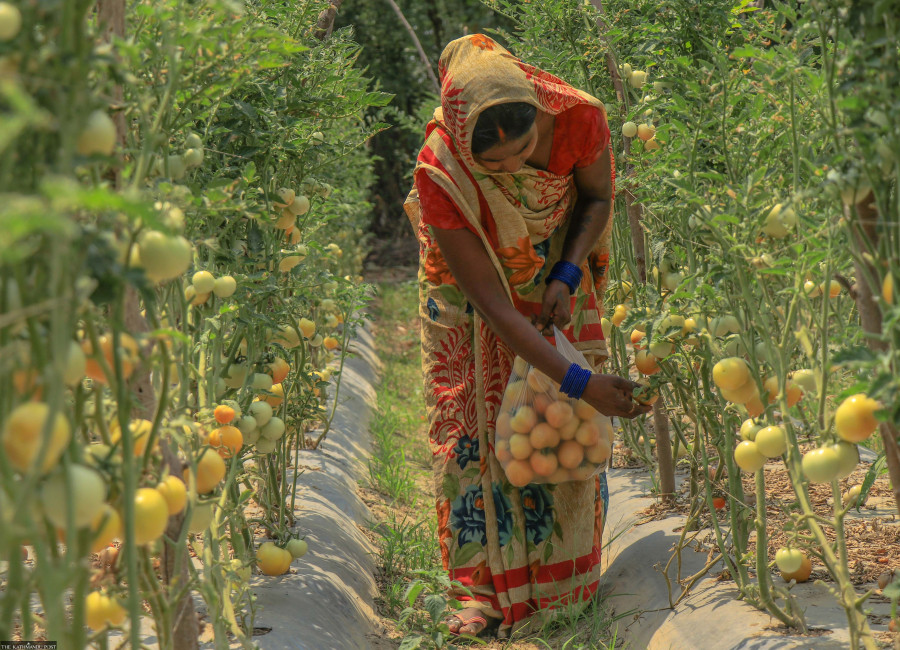Money
Why tomatoes have become so expensive in Nepal
A tomato scarcity in India has sent prices soaring to unreal heights, and Nepali traders are scrambling to export their stocks.
Krishana Prasain
Last June, farmers dumped truckloads of tomatoes on the road outside the Kalimati Fruit and Vegetable Market in Kathmandu to vent their anger at the low prices they were getting.
Photos and videos of the mounds of tomatoes in the middle of the road blocking traffic duly appeared on social media. Eventually, the city's bulldozers arrived and scooped up the squishy vegetables and cleared the road.
As per Kalimati vegetable market sources, farmers had thrown around 90 tonnes of tomatoes on the street.
The tomato growers said they were forced to dump their produce because they were not able to get a fair price, and there was no way they could compete with cheap Indian tomatoes flooding the market.
The market price of Nepali tomatoes at that time was Rs35 per kg, while farmers received Rs10 per kg for their harvest.
Farmers in Chitwan had thrown a similar tantrum last February by tossing out tonnes of tomatoes and other vegetables on the road for not getting paid enough.
Tomato prices are currently at an all-time high. The wholesale price of the indispensable vegetable is Rs180 per kg while retail customers pay Rs220 per kg.
The price has soared not because tomatoes are in short supply in Nepal. There is plenty to go around. Nepali farmers grow tomatoes on 22,600 hectares and produce more than 432,000 tonnes annually, according to the Agriculture Ministry.
The scarcity is in India where prices have reached unreal heights. Tomato costs more than chicken down south. This has got Nepali traders scrambling to export tomatoes to India.
According to media reports, the price of tomato was IRs203 (Rs324) per kg in major Indian cities on July 25, almost triple from last year.
Tomato is indispensable in South Asian cooking. The red vegetable forms the base for curries and almost everything else, and life without it is unimaginable. A tomato shortage in India is thus a boon for Nepali vegetable traders.
Binay Shrestha, information officer at the Kalimati Fruits and Vegetable Market Development Board, says Nepali traders are exporting tomatoes in massive quantities and causing supply constraints on the domestic front.
“Nepali traders are selling tomatoes for nearly Rs300 per kg in the Indian market.” Indian media reported that tomato prices may reach IRs300 per kg.
The news said that the Indian people had found a solution to the problem of surging tomato prices: Buy tomatoes across the border in Nepal, where the food staple can be found for almost half the price.
Nepal is not only a big food importer from India, but it also exports major spices and vegetables like tea, large cardamom, ginger and cabbage to the southern neighbour.
This year, due to a shortage of various farm produce in India, Nepali producers are seeing their business boom.
The price of large cardamom jumped to Rs1,000 per kg from Rs700 per kg. Similarly, the price of ginger has swelled to Rs250 per kg in the Indian market from Rs40 per kg.
Media reports say climate change is the main reason behind this year's tomato shortage in India. Much of the country has experienced erratic weather patterns in the first six months of 2023, with heat waves arriving early and lasting longer, and extreme rainfall damaging crops.
The reports said that in major tomato-producing Indian states like Andhra Pradesh, Maharashtra and Karnataka, flooding was the main cause behind the price surge.
“Whatever the reason, opportunist traders are taking undue advantage of the shortage in India. They are exporting Nepali tomatoes to India and creating a shortage in Nepal,” said Prem Lal Maharjan, a consumer rights activist.
“There has been a six-fold hike in the price of tomato in just a few weeks.”
Two months ago, farmers had launched protests demanding that the government stop all vegetable imports from India as they were not getting fair prices for their produce.
“Now, the bulk of Nepal's tomato harvest is being exported to India because of the massive profits. The suppliers are not farmers,” said Maharjan, adding that powerful middlemen were exploiting the market for short-term gains.
Normally, the June-August period or the monsoon is considered the off-season for vegetable production in Nepal as most of the farmlands are covered with paddy.
In the past, the beginning of the paddy season would mark the end of tomato and other vegetable deliveries in the market. But nowadays with commercial tunnel farming, there is an ample supply coming to Kathmandu.
Tomato cultivation using plastic tunnels has been gaining popularity across the country due to higher productivity and income compared to traditional cereal crop production.
Out-of-season tomato cultivation has been bringing good income to many farmers.
Plastic tunnels are small greenhouse-like structures inside which the plants are grown. The new technique has increased the supply of vegetables in the market.
The tunnels are erected with bamboo and covered with clear plastic. Farmers say vegetables can be grown with bumper yields and promising earnings as this technique requires less land.
“Obviously, tunnel farming has thrived and there is no off-season nowadays. But this year, tomatoes produced in tunnels in the southern Tarai are being supplied to the Indian market,” said Shrestha from the Kalimati market.
The country's largest produce bazaar was receiving 60-65 tonnes of tomato daily. “Now, the supply has more than halved,” said Shrestha.
"The tomatoes sold in Kathmandu come from neighbouring districts, but the supply is not sufficient to meet demand," he said.
The rise in tomato prices in Nepal is another blow to inflation-hit Nepalis.
“The local levels should inspect the markets and the borders too to control prices,” said consumer rights activist Maharjan.




 10.12°C Kathmandu
10.12°C Kathmandu














